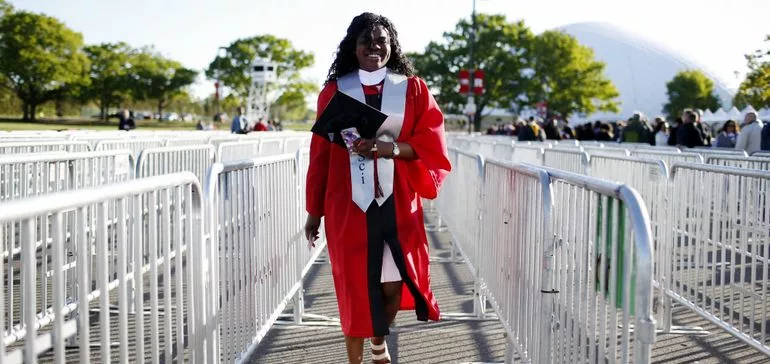[ad_1]
Dive Brief:
- On-time completion rates for college students ticked up across most U.S. states from 2016 to 2021, according to a new report from Complete College America, a nonprofit aiming to improve postsecondary attainment.
- Improvements varied considerably. On-time completion rates for four-year college students in Hawaii rose from 18% to 30% over the period. Meanwhile, rates for four-year college students in Virginia grew by a smaller amount, rising from 52% to 57%.
- The report also unearthed widespread disparities between student groups. Part-time students at both four-year and community colleges are much less likely to graduate within six years than full-time students, signaling a need for colleges to better support this group, according to Complete College America.
Dive Insight:
The report offers promising news to the higher education sector, which has long struggled with getting students to complete bachelor’s and associate degrees within their prescribed four- and two-year timeframes. In most states, less than half of students attending either four-year institutions or community colleges graduate on time.
New Mexico, for example, has one of the lowest on-time graduation rates for four-year college students, with only 25% completing their credential on time in 2021. But that’s a significant improvement from 14% in 2016.
The Complete College America report credits recent reforms adopted by states and college systems for those kinds of completion gains. The nonprofit formed an alliance of colleges adopting several policies, including moving away from remedial coursework and using multiple measures in course placement, rather than relying on high-stakes exams.
The alliance counts more than half of U.S. states as members, as well as other groups. Its analysis looked at how completion rates have changed across Complete College America members who joined the alliance before 2018. That includes the City University of New York system.
But Complete College America calls for further work to address deep disparities between student groups. For instance, only 21% of four-year college students who exclusively attend part time graduate within six years, compared to 69% of all students. And only 19% of part-time community college students graduate within six years, compared to 42% of all students.
These trends exacerbate existing inequities. Black, Indigenous and Latinx students, students of color, and those aged 25 and older are all more likely to attend college part-time, according to the report. They are also less likely to graduate.
“More action is needed,” said Charles Ansell, the nonprofit’s vice president for research, policy and advocacy. “We do know what works, we’re just not doing it enough.”
Ansell pointed to reforms that improve metrics that predict whether students will graduate. Those metrics include the share of full-time students that obtain 30 credits in their first year, as well as the percentage of part-time students that obtain 15 credits.
Colleges should encourage students to craft semester-by-semester academic plans to avoid accumulating credits that don’t count toward their degree program, the report recommends. It also says they should ensure credits go toward their degree requirements, according to the report.
Officials should also encourage students to quickly declare majors — even if they change their minds later — to provide them with academic focus. And they should award credit for prior learning to help speed students’ credit accumulation.
Although some of these initiatives are costly, they can end up generating revenue.
While providing credit for work-based learning means colleges don’t receive money for those courses, they can make up revenue through the classes those students take afterward, Ansell said.
Past research has found that higher shares of students who receive college credit through prior learning assessments earn credentials than those who didn’t. College officials theorize this is partly because prior-learning credits motivate students to complete their programs.
Ansell suggested colleges implement some of these practices at scale rather than piloting them first.
“Every year you waste is a moral shortcoming,” Ansell said. “It’s an injustice to not put into place proven reforms at scale. It’d be like if everybody tested the new vaccine on a state-by-state basis.”
[ad_2]
Source link
Meet Our Successful Graduates: Learn how our courses have propelled graduates into rewarding
careers. Explore their success stories here!
Discover More About Your Future: Interested in advancing your teaching career? Explore our
IPGCE, MA, and QTS courses today!


